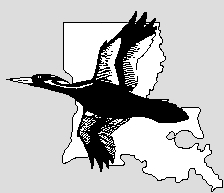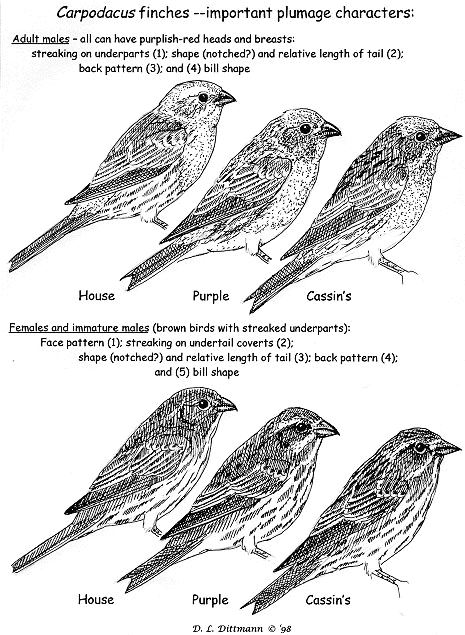
Donna L. Dittmann and Steven W. Cardiff
Museum of Natural Science
119 Foster Hall, Louisiana State University
Let's take another look:
As Christmas Bird Counts are just around the corner, it seems like a good time to pick an under-publicized winter ID problem to review. Although field-guides seem to address the ID of this finch group adequately, it never hurts to re-emphasize ID features. Sometimes it just takes reorganizing the information into an easier format.
There are twenty-one species of Carpodacus finches. Most species in the genus occur in the Old World, with most representatives in Asia. The group is collectively referred to as the rosefinches to acknowledge the coloration of the males. Three species occur regularly in the US: House Finch (Carpodacus mexicanus), Purple Finch (C. purpureus), and Cassin's Finch (C. cassinii). One additional species has occurred as a vagrant (Alaska): Common Rosefinch (C. erythrinus). Only Purple and House finches have occurred in Louisiana.
House Finch is a relative newcomer to Louisiana. as an Introduced Species. After an illegal release of birds from a pet store in New York in 1940, this adaptable species (whose native range was the West and Mexico) gradually spread throughout the eastern US. The first report from Louisiana was from a feeder during the winter of 1977-78 in Natchitoches. It was accepted to the State List in 1986 as an Introduced Species. House Finch can now be found breeding in many urban and suburban areas of our state. House Finch numbers increase during the winter as northern birds move south to winter, and as individuals congregate at feeding stations. Peak counts occurred during winter 1995-96, but numbers dropped in subsequent years - coincidental with increasing reports of birds infected with avian conjunctivitis. Over the last decade, House Finch has become the expected Carpodacus at feeders.
Purple Finch is an irruptive species. Breeding well to the north of Louisiana, numbers of individuals visiting Louisiana vary from winter to winter from a few to many hundreds. Our last sizable invasions penetrating into southern Louisiana were in the mid-80s. At least a few Purple Finches are detected most winters. Purple Finch is rare before late November and rare after March, so any non-winter Carpodacus is more likely a House Finch. Suspected Purple Finches at feeders during non-invasion winters should be carefully scrutinized to rule out House Finch. Purple Finch is a regular at feeders, but many individuals may be found foraging away from feeders on pinecone crops, especially in pinewoods of the northeastern part of the state. This is especially true during non-invasion years.
Cassin's Finch, a western montane species, and a possible vagrant to Louisiana. Like Purple Finch, it is also an irruptive species. So, to sleuth out the possible Cassin's at your feeder (males and females resemble Purple Finch), you will have to be very familiar with the other two species! Fortunately, both House and Purple finches are easily drawn to sunflower and thistle seed feeders in urban and rural yards, where close, leisurely studies are possible.
House, Purple, and Cassin's finches are sexually dimorphic. Males are brightly dressed with a reddish head and breast. Purple and Cassin's finches tend to be more purplish-red than typical House Finches, which average more orange-red. But, some House Finches overlap in color with Purple, which is likely the cause most of the ID problems--a purplish-red finch is not necessarily a Purple. Females of all three species are generally dull brown above and white below, the white streaked with brown. Immature males are essentially identical to females until they obtain their adult colors in their second year. A mall percentage of immature males and adult females may show varying degrees of red in the plumage. The entire underparts may be washed with rose, or it may be restricted to the crown, chin, or cheeks. For that reason it is difficult to identify immature males versus females, unless, of course, the bird is singing!
The general structure of the two regularly-occurring species is very different. The most important features are: bill shape and size, overall body proportions, and shape of the tail.
House Finch is recognized by its more slender body proportions, short primary extention (the amount of "wing tip" that extends past the folded secondary feathers), and long, un-notched tail. Bill shape is also very different than the other two species. The culmen (ridge or top of the upper mandible) is curved throughout and giving the bill a somewhat "parrot-like" appearance.
Purple Finch is heavier-billed, the culmen is straight, but then has a distinct curve near the tip. Although there is overlap on the size of the bill with House Finch, in general, Purple Finch appears to be relatively larger-billed. The body is generally plumper and fluffier compared to a House Finch, and the tail is shorter and prominently notched. Purple Finch has a much greater primary projection.
Cassin's Finch is most similar to Purple Finch in overall bill and body proportions, and tail notch. The most notable difference is the shape of the bill. The bill appears large, like a Purple Finch, but has a straight culmen without the curve at the tip. This gives the bill a very triangular-look or chisel-like appearance.
Adult males = birds with red crowns and breasts.
The most important features to study are the shape of the bill, coloration of the back, shape of the tail, and pattern of the undertail coverts.
House Finch has underparts streaked with brown beneath the red breast. The color of "red" can vary from a pale yellow to orange, reddish-orange, or purplish-red (same as a Purple or Cassin's finch). The red does not often bleed onto the plain brown back. The undertail coverts are distinctly streaked.
Purple Finch has clean, unstreaked underparts, usually including the undertail coverts. The flanks may have streaks, but these do not continue across the belly as does the streaking on a House Finch. The typical color of the head and breast is a rose-red, wine-red, or purplish-red. The color never approaches the orange-red tones of the House Finch. The crown is often the most brightly colored area on the bird, and the reddish color usually continues as a wash down the back, which is only vaguely streaked. There is varying amounts of grissled-white in front of the eye and across the forehead, a pattern essentially lacking in House Finch. Some birds also have a hint of head markings similar to female-plumaged birds, including a brownish cheek patch and moustache stripe.
Cassin's Finch has unstreaked underparts except for streaking on the undertail coverts and sometimes on the flanks. The flank streaking is usually very fine, unlike the coarser streaking of the Purple. Some red-breasted males (younger individuals?) show streaking on the sides. The back is noticeably streaked with darker brown. The "red" coloration is most similar to a Purple Finch (and similarly does not show the range of colors as a House Finch). The purplish-red is brightest on the crown and is accentuated by the brown-streaked back. The breast is typically paler purplish-red. Cassin's also shares with the Purple the grissled-white areas on the face, as well as the hint of female-type head markings.
Females and immature males = brown birds with streaks.
Female-plumaged birds (including immature males) are probably more distinct once you get past the superficial appearance of a generally brown-backed bird with a dark-streaked dull white breast. Important features are those of the head (pattern and bill structure), degree of streaking on the back (especially important to ID a Cassin's Finch), and pattern of the undertail coverts. Purple and House finches have relatively uniform back patterns, Purple appearing slightly more streaked, and Cassin's is obviously streaked. Pine Siskin (Carduelis pinus) is also a brown bird with streaks. It is approximately 1/3 smaller than the three Carpodacus species an has a very small pointed bill. Most individuals also show a prominent yellow stripe in the primaries, lacking in the Carpodacus finches.
Purple Finch has a pronounced face pattern: light post-supercilliary stripe, dark cheek patch, and a dark malar patch (like a heavy moustache). The chin may sometimes appear all dark as some females have streaks between the moustache stripes, whereas other females appear white-chinned. There is usually white in the loral area and on the forehead. The face pattern literally jumps out at you. The streaking on the underparts is either formed by indistinct arrowhead-shaped blobs of dark or thick long streaks. Undertail coverts are essentially all white; some individuals may have obscure streaks (more common in the western subspecies that sports a more "greener" tone to the upperparts).
House Finch is relatively bland-looking. The post-supercilliary stripe is usually barely visible, there is no pronounced cheek patch, and there is no moustache mark, so the head looks more uniformly brown. There is usually no white on the forehead or in the loral area. The underpart streaks of House Finch are generally thinner.
Cassin's Finch is very similar in appearance to Purple Finch. The major plumage difference being the streaked back and undertail coverts.
Vocalizations.
The call notes of the three species are very different. Away from feeders, these species are often first located by their flight notes as they hurtle overhead. Away from feeders, this is the way birds are located on CBCs.
House Finch has a simple, House Sparrow-like chirp. A good rendition is "churt". House Sparrow is the only bird whose call could easily be confused with House Finch.
Purple Finch as a single, "pick" note. Beware of confusion with distinct Red-winged Blackbird call notes.
Cassin's Finch utters a more complex two-three-noted "chi de ep" call.
